University Business Research Methods: Conspicuous Consumption Analysis
VerifiedAdded on 2023/04/21
|7
|1724
|312
Report
AI Summary
This report is a structured abstract based on a literature review of conspicuous consumption, a concept where individuals intentionally waste money to display financial power and improve social status. The report analyzes four academic articles, including one that proposes the theory and three more recent articles employing quantitative, qualitative, and mixed-method research designs. It summarizes the theory's progression, common and different themes across the articles (including customer satisfaction, buying behavior, customer motivation, and experience quality), study limitations, and future research directions. The analysis covers various aspects such as the influence of personality traits, the role of social and material needs, the impact of busyness, and the effects of digital media on consumption patterns. The report highlights limitations in each study and suggests areas for future research, such as exploring the applicability of findings in diverse contexts and the impact of digital marketing strategies.
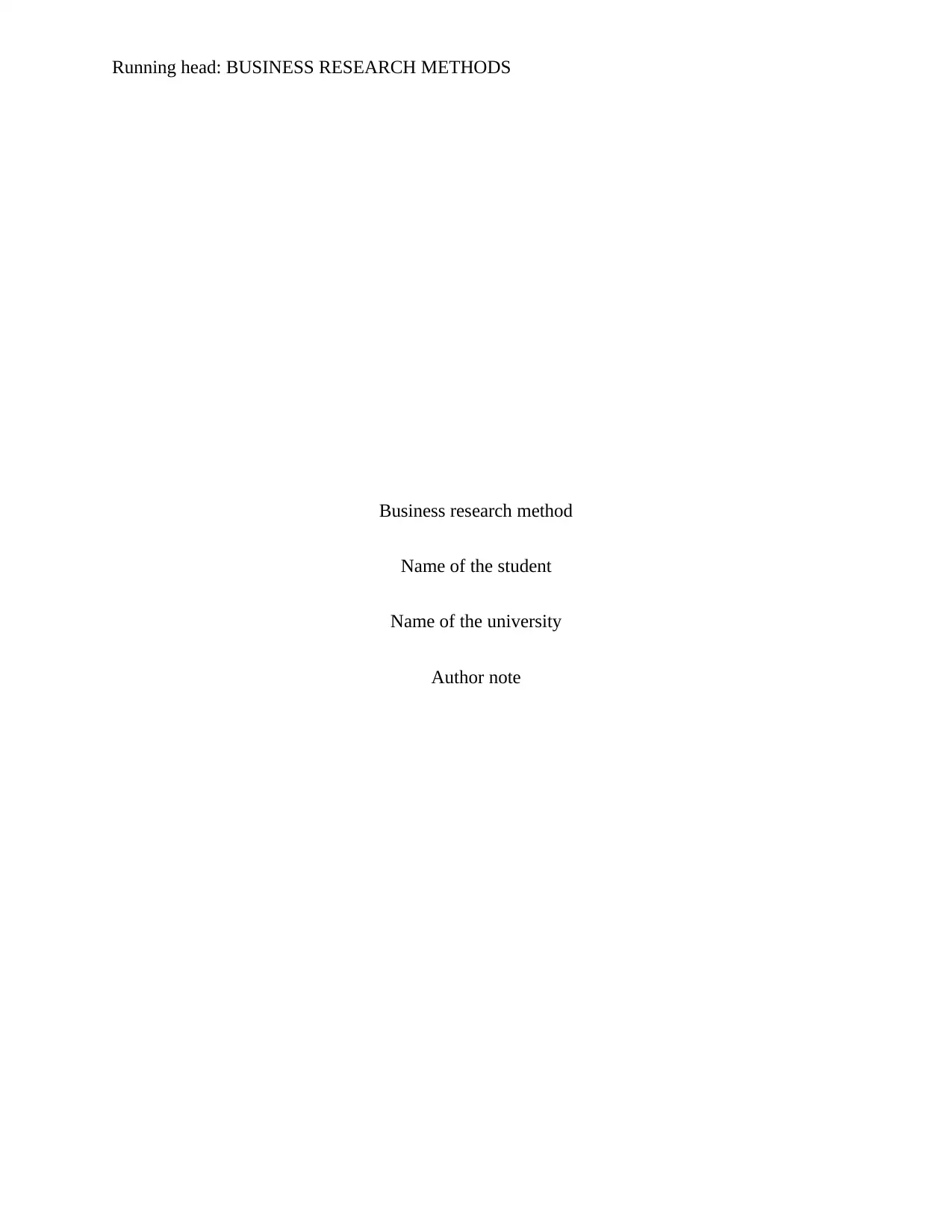
Running head: BUSINESS RESEARCH METHODS
Business research method
Name of the student
Name of the university
Author note
Business research method
Name of the student
Name of the university
Author note
Paraphrase This Document
Need a fresh take? Get an instant paraphrase of this document with our AI Paraphraser
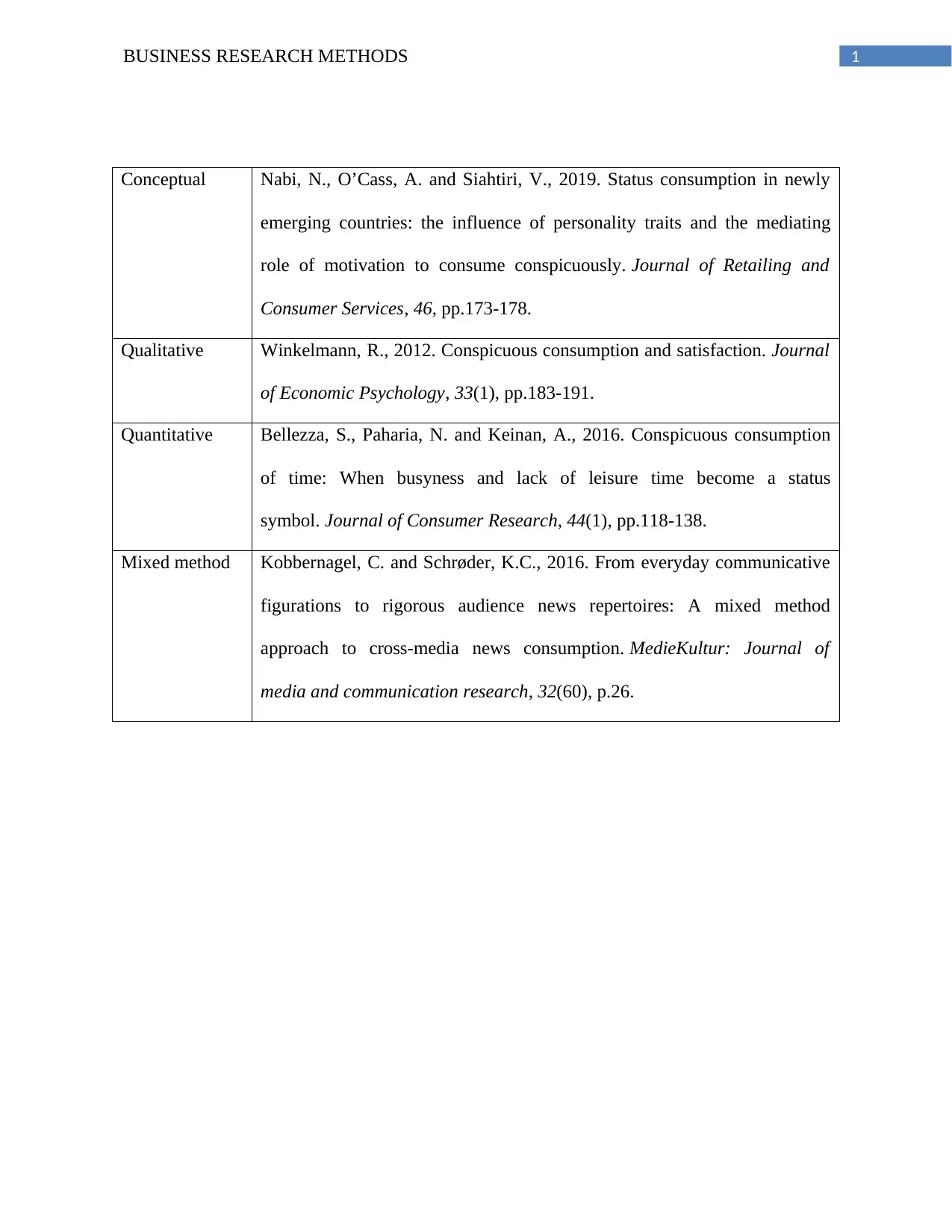
1BUSINESS RESEARCH METHODS
Conceptual Nabi, N., O’Cass, A. and Siahtiri, V., 2019. Status consumption in newly
emerging countries: the influence of personality traits and the mediating
role of motivation to consume conspicuously. Journal of Retailing and
Consumer Services, 46, pp.173-178.
Qualitative Winkelmann, R., 2012. Conspicuous consumption and satisfaction. Journal
of Economic Psychology, 33(1), pp.183-191.
Quantitative Bellezza, S., Paharia, N. and Keinan, A., 2016. Conspicuous consumption
of time: When busyness and lack of leisure time become a status
symbol. Journal of Consumer Research, 44(1), pp.118-138.
Mixed method Kobbernagel, C. and Schrøder, K.C., 2016. From everyday communicative
figurations to rigorous audience news repertoires: A mixed method
approach to cross-media news consumption. MedieKultur: Journal of
media and communication research, 32(60), p.26.
Conceptual Nabi, N., O’Cass, A. and Siahtiri, V., 2019. Status consumption in newly
emerging countries: the influence of personality traits and the mediating
role of motivation to consume conspicuously. Journal of Retailing and
Consumer Services, 46, pp.173-178.
Qualitative Winkelmann, R., 2012. Conspicuous consumption and satisfaction. Journal
of Economic Psychology, 33(1), pp.183-191.
Quantitative Bellezza, S., Paharia, N. and Keinan, A., 2016. Conspicuous consumption
of time: When busyness and lack of leisure time become a status
symbol. Journal of Consumer Research, 44(1), pp.118-138.
Mixed method Kobbernagel, C. and Schrøder, K.C., 2016. From everyday communicative
figurations to rigorous audience news repertoires: A mixed method
approach to cross-media news consumption. MedieKultur: Journal of
media and communication research, 32(60), p.26.
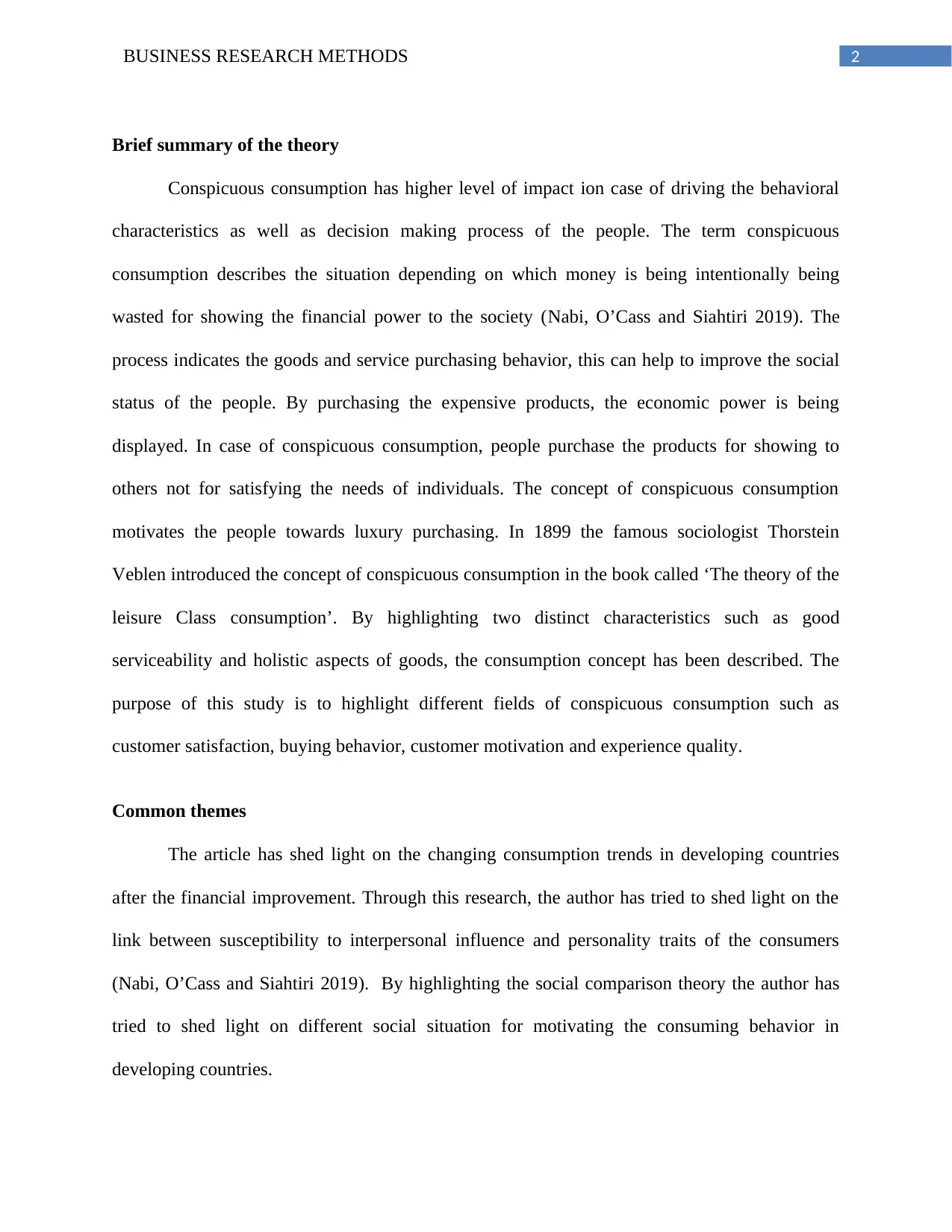
2BUSINESS RESEARCH METHODS
Brief summary of the theory
Conspicuous consumption has higher level of impact ion case of driving the behavioral
characteristics as well as decision making process of the people. The term conspicuous
consumption describes the situation depending on which money is being intentionally being
wasted for showing the financial power to the society (Nabi, O’Cass and Siahtiri 2019). The
process indicates the goods and service purchasing behavior, this can help to improve the social
status of the people. By purchasing the expensive products, the economic power is being
displayed. In case of conspicuous consumption, people purchase the products for showing to
others not for satisfying the needs of individuals. The concept of conspicuous consumption
motivates the people towards luxury purchasing. In 1899 the famous sociologist Thorstein
Veblen introduced the concept of conspicuous consumption in the book called ‘The theory of the
leisure Class consumption’. By highlighting two distinct characteristics such as good
serviceability and holistic aspects of goods, the consumption concept has been described. The
purpose of this study is to highlight different fields of conspicuous consumption such as
customer satisfaction, buying behavior, customer motivation and experience quality.
Common themes
The article has shed light on the changing consumption trends in developing countries
after the financial improvement. Through this research, the author has tried to shed light on the
link between susceptibility to interpersonal influence and personality traits of the consumers
(Nabi, O’Cass and Siahtiri 2019). By highlighting the social comparison theory the author has
tried to shed light on different social situation for motivating the consuming behavior in
developing countries.
Brief summary of the theory
Conspicuous consumption has higher level of impact ion case of driving the behavioral
characteristics as well as decision making process of the people. The term conspicuous
consumption describes the situation depending on which money is being intentionally being
wasted for showing the financial power to the society (Nabi, O’Cass and Siahtiri 2019). The
process indicates the goods and service purchasing behavior, this can help to improve the social
status of the people. By purchasing the expensive products, the economic power is being
displayed. In case of conspicuous consumption, people purchase the products for showing to
others not for satisfying the needs of individuals. The concept of conspicuous consumption
motivates the people towards luxury purchasing. In 1899 the famous sociologist Thorstein
Veblen introduced the concept of conspicuous consumption in the book called ‘The theory of the
leisure Class consumption’. By highlighting two distinct characteristics such as good
serviceability and holistic aspects of goods, the consumption concept has been described. The
purpose of this study is to highlight different fields of conspicuous consumption such as
customer satisfaction, buying behavior, customer motivation and experience quality.
Common themes
The article has shed light on the changing consumption trends in developing countries
after the financial improvement. Through this research, the author has tried to shed light on the
link between susceptibility to interpersonal influence and personality traits of the consumers
(Nabi, O’Cass and Siahtiri 2019). By highlighting the social comparison theory the author has
tried to shed light on different social situation for motivating the consuming behavior in
developing countries.
⊘ This is a preview!⊘
Do you want full access?
Subscribe today to unlock all pages.

Trusted by 1+ million students worldwide
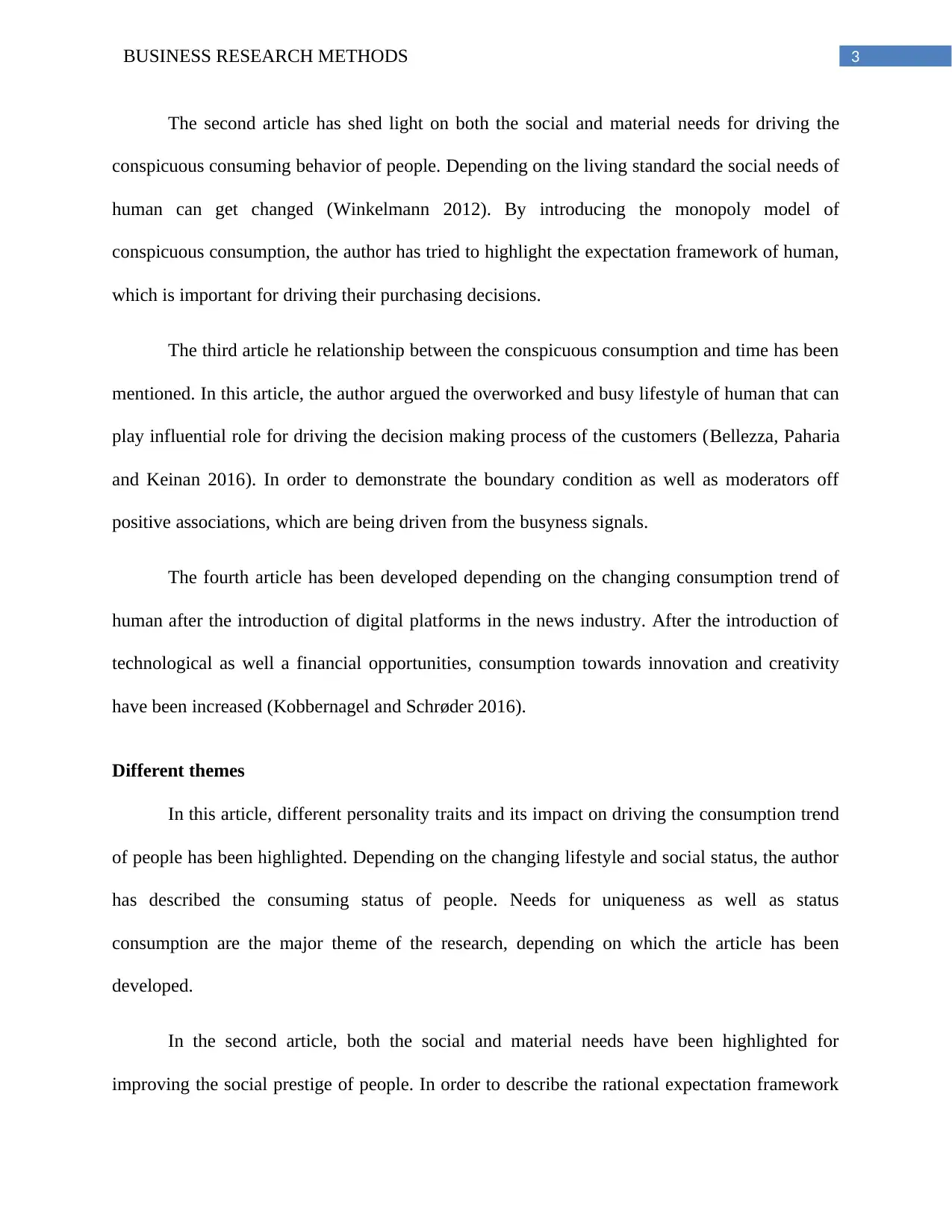
3BUSINESS RESEARCH METHODS
The second article has shed light on both the social and material needs for driving the
conspicuous consuming behavior of people. Depending on the living standard the social needs of
human can get changed (Winkelmann 2012). By introducing the monopoly model of
conspicuous consumption, the author has tried to highlight the expectation framework of human,
which is important for driving their purchasing decisions.
The third article he relationship between the conspicuous consumption and time has been
mentioned. In this article, the author argued the overworked and busy lifestyle of human that can
play influential role for driving the decision making process of the customers (Bellezza, Paharia
and Keinan 2016). In order to demonstrate the boundary condition as well as moderators off
positive associations, which are being driven from the busyness signals.
The fourth article has been developed depending on the changing consumption trend of
human after the introduction of digital platforms in the news industry. After the introduction of
technological as well a financial opportunities, consumption towards innovation and creativity
have been increased (Kobbernagel and Schrøder 2016).
Different themes
In this article, different personality traits and its impact on driving the consumption trend
of people has been highlighted. Depending on the changing lifestyle and social status, the author
has described the consuming status of people. Needs for uniqueness as well as status
consumption are the major theme of the research, depending on which the article has been
developed.
In the second article, both the social and material needs have been highlighted for
improving the social prestige of people. In order to describe the rational expectation framework
The second article has shed light on both the social and material needs for driving the
conspicuous consuming behavior of people. Depending on the living standard the social needs of
human can get changed (Winkelmann 2012). By introducing the monopoly model of
conspicuous consumption, the author has tried to highlight the expectation framework of human,
which is important for driving their purchasing decisions.
The third article he relationship between the conspicuous consumption and time has been
mentioned. In this article, the author argued the overworked and busy lifestyle of human that can
play influential role for driving the decision making process of the customers (Bellezza, Paharia
and Keinan 2016). In order to demonstrate the boundary condition as well as moderators off
positive associations, which are being driven from the busyness signals.
The fourth article has been developed depending on the changing consumption trend of
human after the introduction of digital platforms in the news industry. After the introduction of
technological as well a financial opportunities, consumption towards innovation and creativity
have been increased (Kobbernagel and Schrøder 2016).
Different themes
In this article, different personality traits and its impact on driving the consumption trend
of people has been highlighted. Depending on the changing lifestyle and social status, the author
has described the consuming status of people. Needs for uniqueness as well as status
consumption are the major theme of the research, depending on which the article has been
developed.
In the second article, both the social and material needs have been highlighted for
improving the social prestige of people. In order to describe the rational expectation framework
Paraphrase This Document
Need a fresh take? Get an instant paraphrase of this document with our AI Paraphraser
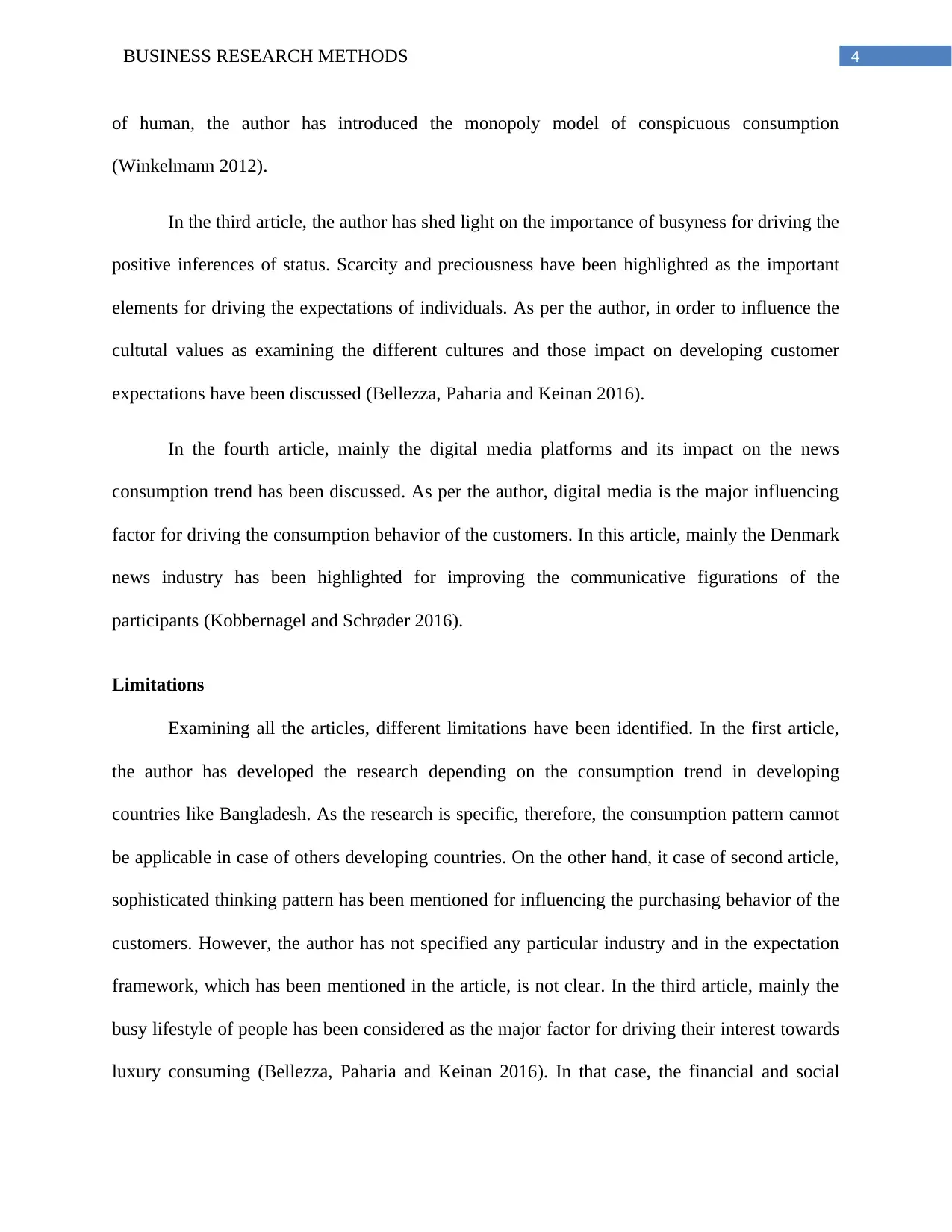
4BUSINESS RESEARCH METHODS
of human, the author has introduced the monopoly model of conspicuous consumption
(Winkelmann 2012).
In the third article, the author has shed light on the importance of busyness for driving the
positive inferences of status. Scarcity and preciousness have been highlighted as the important
elements for driving the expectations of individuals. As per the author, in order to influence the
cultutal values as examining the different cultures and those impact on developing customer
expectations have been discussed (Bellezza, Paharia and Keinan 2016).
In the fourth article, mainly the digital media platforms and its impact on the news
consumption trend has been discussed. As per the author, digital media is the major influencing
factor for driving the consumption behavior of the customers. In this article, mainly the Denmark
news industry has been highlighted for improving the communicative figurations of the
participants (Kobbernagel and Schrøder 2016).
Limitations
Examining all the articles, different limitations have been identified. In the first article,
the author has developed the research depending on the consumption trend in developing
countries like Bangladesh. As the research is specific, therefore, the consumption pattern cannot
be applicable in case of others developing countries. On the other hand, it case of second article,
sophisticated thinking pattern has been mentioned for influencing the purchasing behavior of the
customers. However, the author has not specified any particular industry and in the expectation
framework, which has been mentioned in the article, is not clear. In the third article, mainly the
busy lifestyle of people has been considered as the major factor for driving their interest towards
luxury consuming (Bellezza, Paharia and Keinan 2016). In that case, the financial and social
of human, the author has introduced the monopoly model of conspicuous consumption
(Winkelmann 2012).
In the third article, the author has shed light on the importance of busyness for driving the
positive inferences of status. Scarcity and preciousness have been highlighted as the important
elements for driving the expectations of individuals. As per the author, in order to influence the
cultutal values as examining the different cultures and those impact on developing customer
expectations have been discussed (Bellezza, Paharia and Keinan 2016).
In the fourth article, mainly the digital media platforms and its impact on the news
consumption trend has been discussed. As per the author, digital media is the major influencing
factor for driving the consumption behavior of the customers. In this article, mainly the Denmark
news industry has been highlighted for improving the communicative figurations of the
participants (Kobbernagel and Schrøder 2016).
Limitations
Examining all the articles, different limitations have been identified. In the first article,
the author has developed the research depending on the consumption trend in developing
countries like Bangladesh. As the research is specific, therefore, the consumption pattern cannot
be applicable in case of others developing countries. On the other hand, it case of second article,
sophisticated thinking pattern has been mentioned for influencing the purchasing behavior of the
customers. However, the author has not specified any particular industry and in the expectation
framework, which has been mentioned in the article, is not clear. In the third article, mainly the
busy lifestyle of people has been considered as the major factor for driving their interest towards
luxury consuming (Bellezza, Paharia and Keinan 2016). In that case, the financial and social
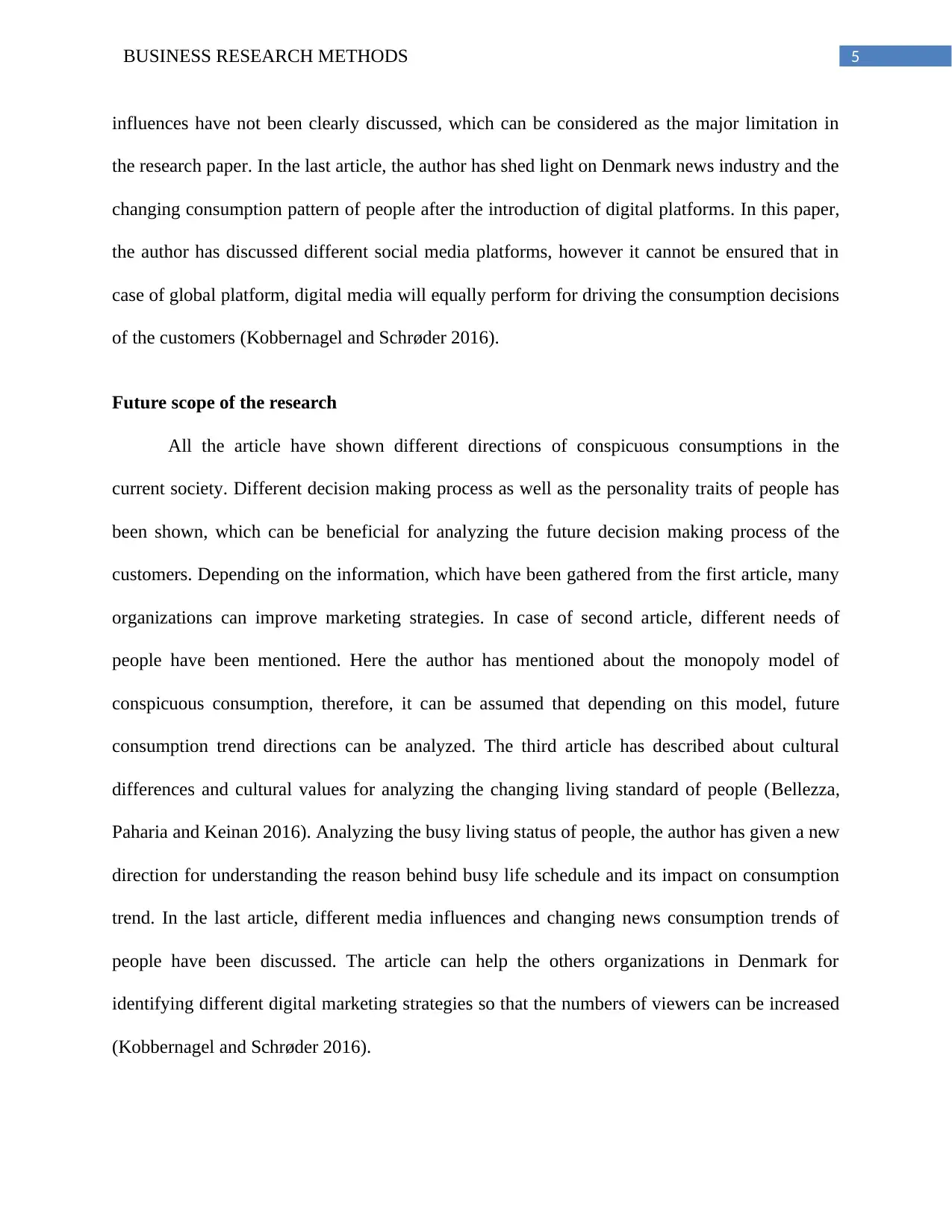
5BUSINESS RESEARCH METHODS
influences have not been clearly discussed, which can be considered as the major limitation in
the research paper. In the last article, the author has shed light on Denmark news industry and the
changing consumption pattern of people after the introduction of digital platforms. In this paper,
the author has discussed different social media platforms, however it cannot be ensured that in
case of global platform, digital media will equally perform for driving the consumption decisions
of the customers (Kobbernagel and Schrøder 2016).
Future scope of the research
All the article have shown different directions of conspicuous consumptions in the
current society. Different decision making process as well as the personality traits of people has
been shown, which can be beneficial for analyzing the future decision making process of the
customers. Depending on the information, which have been gathered from the first article, many
organizations can improve marketing strategies. In case of second article, different needs of
people have been mentioned. Here the author has mentioned about the monopoly model of
conspicuous consumption, therefore, it can be assumed that depending on this model, future
consumption trend directions can be analyzed. The third article has described about cultural
differences and cultural values for analyzing the changing living standard of people (Bellezza,
Paharia and Keinan 2016). Analyzing the busy living status of people, the author has given a new
direction for understanding the reason behind busy life schedule and its impact on consumption
trend. In the last article, different media influences and changing news consumption trends of
people have been discussed. The article can help the others organizations in Denmark for
identifying different digital marketing strategies so that the numbers of viewers can be increased
(Kobbernagel and Schrøder 2016).
influences have not been clearly discussed, which can be considered as the major limitation in
the research paper. In the last article, the author has shed light on Denmark news industry and the
changing consumption pattern of people after the introduction of digital platforms. In this paper,
the author has discussed different social media platforms, however it cannot be ensured that in
case of global platform, digital media will equally perform for driving the consumption decisions
of the customers (Kobbernagel and Schrøder 2016).
Future scope of the research
All the article have shown different directions of conspicuous consumptions in the
current society. Different decision making process as well as the personality traits of people has
been shown, which can be beneficial for analyzing the future decision making process of the
customers. Depending on the information, which have been gathered from the first article, many
organizations can improve marketing strategies. In case of second article, different needs of
people have been mentioned. Here the author has mentioned about the monopoly model of
conspicuous consumption, therefore, it can be assumed that depending on this model, future
consumption trend directions can be analyzed. The third article has described about cultural
differences and cultural values for analyzing the changing living standard of people (Bellezza,
Paharia and Keinan 2016). Analyzing the busy living status of people, the author has given a new
direction for understanding the reason behind busy life schedule and its impact on consumption
trend. In the last article, different media influences and changing news consumption trends of
people have been discussed. The article can help the others organizations in Denmark for
identifying different digital marketing strategies so that the numbers of viewers can be increased
(Kobbernagel and Schrøder 2016).
⊘ This is a preview!⊘
Do you want full access?
Subscribe today to unlock all pages.

Trusted by 1+ million students worldwide
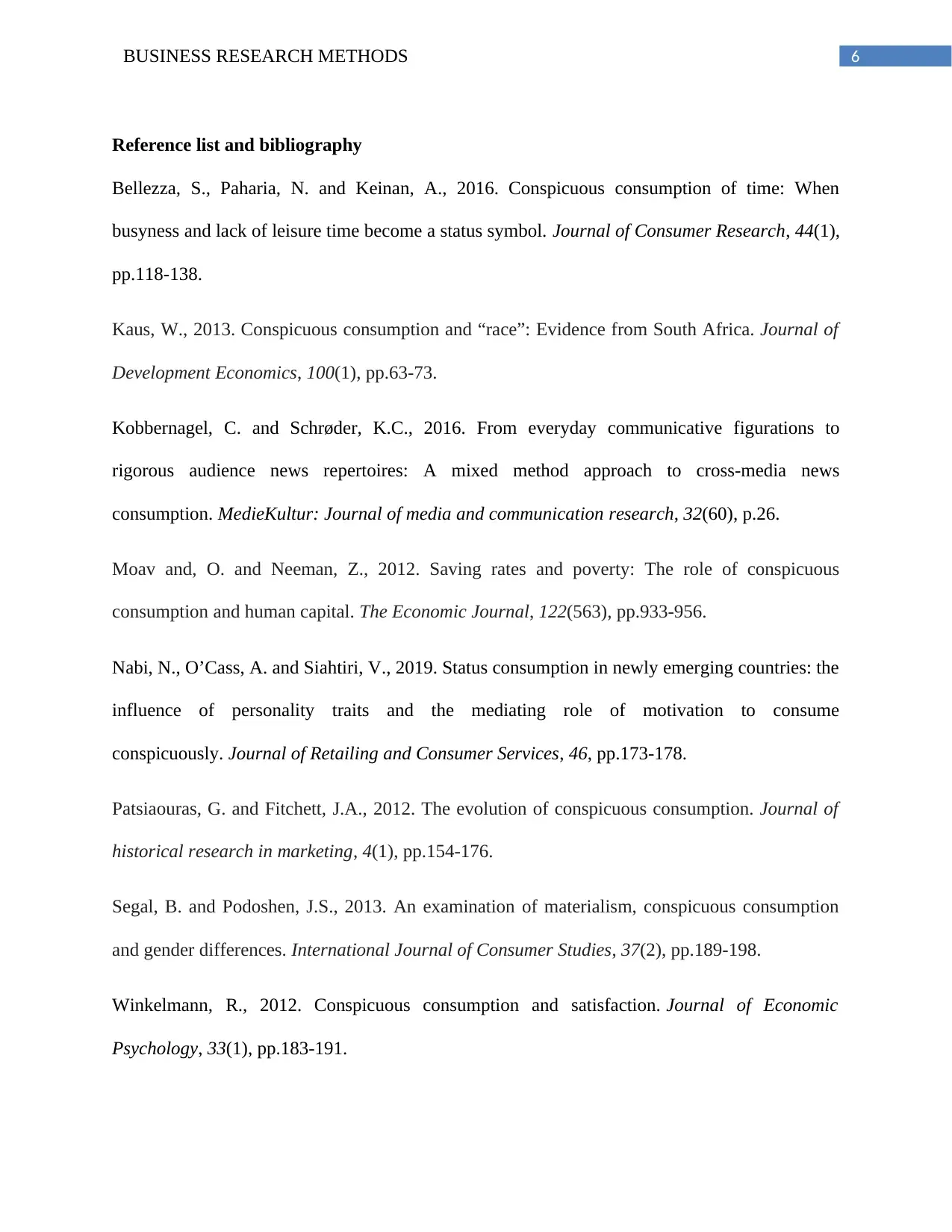
6BUSINESS RESEARCH METHODS
Reference list and bibliography
Bellezza, S., Paharia, N. and Keinan, A., 2016. Conspicuous consumption of time: When
busyness and lack of leisure time become a status symbol. Journal of Consumer Research, 44(1),
pp.118-138.
Kaus, W., 2013. Conspicuous consumption and “race”: Evidence from South Africa. Journal of
Development Economics, 100(1), pp.63-73.
Kobbernagel, C. and Schrøder, K.C., 2016. From everyday communicative figurations to
rigorous audience news repertoires: A mixed method approach to cross-media news
consumption. MedieKultur: Journal of media and communication research, 32(60), p.26.
Moav and, O. and Neeman, Z., 2012. Saving rates and poverty: The role of conspicuous
consumption and human capital. The Economic Journal, 122(563), pp.933-956.
Nabi, N., O’Cass, A. and Siahtiri, V., 2019. Status consumption in newly emerging countries: the
influence of personality traits and the mediating role of motivation to consume
conspicuously. Journal of Retailing and Consumer Services, 46, pp.173-178.
Patsiaouras, G. and Fitchett, J.A., 2012. The evolution of conspicuous consumption. Journal of
historical research in marketing, 4(1), pp.154-176.
Segal, B. and Podoshen, J.S., 2013. An examination of materialism, conspicuous consumption
and gender differences. International Journal of Consumer Studies, 37(2), pp.189-198.
Winkelmann, R., 2012. Conspicuous consumption and satisfaction. Journal of Economic
Psychology, 33(1), pp.183-191.
Reference list and bibliography
Bellezza, S., Paharia, N. and Keinan, A., 2016. Conspicuous consumption of time: When
busyness and lack of leisure time become a status symbol. Journal of Consumer Research, 44(1),
pp.118-138.
Kaus, W., 2013. Conspicuous consumption and “race”: Evidence from South Africa. Journal of
Development Economics, 100(1), pp.63-73.
Kobbernagel, C. and Schrøder, K.C., 2016. From everyday communicative figurations to
rigorous audience news repertoires: A mixed method approach to cross-media news
consumption. MedieKultur: Journal of media and communication research, 32(60), p.26.
Moav and, O. and Neeman, Z., 2012. Saving rates and poverty: The role of conspicuous
consumption and human capital. The Economic Journal, 122(563), pp.933-956.
Nabi, N., O’Cass, A. and Siahtiri, V., 2019. Status consumption in newly emerging countries: the
influence of personality traits and the mediating role of motivation to consume
conspicuously. Journal of Retailing and Consumer Services, 46, pp.173-178.
Patsiaouras, G. and Fitchett, J.A., 2012. The evolution of conspicuous consumption. Journal of
historical research in marketing, 4(1), pp.154-176.
Segal, B. and Podoshen, J.S., 2013. An examination of materialism, conspicuous consumption
and gender differences. International Journal of Consumer Studies, 37(2), pp.189-198.
Winkelmann, R., 2012. Conspicuous consumption and satisfaction. Journal of Economic
Psychology, 33(1), pp.183-191.
1 out of 7
Related Documents
Your All-in-One AI-Powered Toolkit for Academic Success.
+13062052269
info@desklib.com
Available 24*7 on WhatsApp / Email
![[object Object]](/_next/static/media/star-bottom.7253800d.svg)
Unlock your academic potential
Copyright © 2020–2025 A2Z Services. All Rights Reserved. Developed and managed by ZUCOL.





